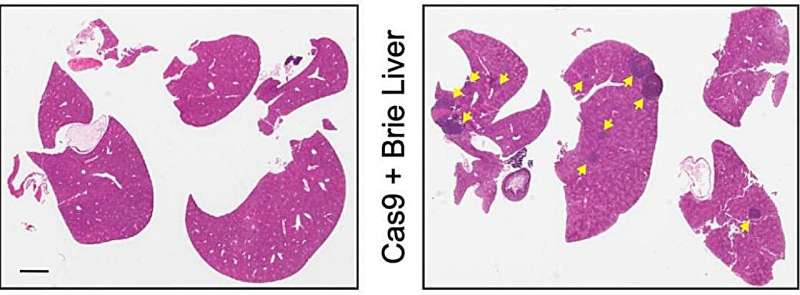This article has been reviewed according to Science X's editorial process and policies. Editors have highlighted the following attributes while ensuring the content's credibility:
fact-checked
trusted source
proofread
Liver metastasis, metabolism, and a therapeutic conundrum

A new study led by researchers at the Herbert Irving Comprehensive Cancer Center (HICCC) has identified a crucial factor that can drive tumor cells to spread to the liver. The work, which is published in the current issue of Nature Cancer, points toward strategies that could help treat these often recalcitrant tumors.
Many types of cancer can spread, or metastasize, to tissues other than the ones in which they originated, but the liver is among the worst destinations for them. "The clinical observation is that patients who have liver metastasis just do poorly in general, [and] they also don't respond as well to all sorts of therapies," says Benjamin Izar, a member of the HICCC and senior author on the new study.
The link between enzymes, cancer, and insulin
To try to understand why, Izar and an international team of collaborators looked for factors that might drive cancer cells toward the liver. The scientists first generated a library of laboratory-cultured melanoma cells, in which each cell had one of several hundred enzymes deleted from its genome.
The specific enzymes they targeted, called kinases, are critical for many aspects of tumor cell biology. Putting the modified cells into an animal model of melanoma, then looking for metastatic tumors, identified the kinases that might be involved in spreading cancer.
Deleting different kinases "didn't seem to change the number of metastases in the lung, but only in the liver," says Izar. Looking closer, the investigators found that the loss of a kinase called Pip4k2C made melanoma cells especially likely to colonize the liver.
Coincidentally, work by another group had recently suggested that Pip4k2C was involved in regulating cells' responses to insulin. Izar's team hypothesized that the insulin-rich environment of the liver was attracting these cells.
Cancer drug increases blood glucose levels, attracting cancer cells to liver
The team used CRISPR-Cas9 to delete Pip4k2c from melanoma cells and found that insulin made these cells more sensitive to activation of the PI3K/AKT pathway, which is critical for cancer growth. Based on this knowledge, Izar's team further hypothesized that using a PI3K inhibitor would shut down the activated pathway, limiting the metastasis to the liver.
However, when they used a PI3K inhibitor to treat the mice with the deleted Pip4k2c melanoma cells, they saw an increase rather than a decrease in the metastatic burden.
"We found that, yes, we'd inhibited the PI3K pathway in the cancer cells, but we more potently inhibited PI3K the cells of the normal liver tissue," says Izar. That boosted the animals' blood glucose levels, which in turn drastically increased insulin levels in the liver, building an even more fertile ground for cancer cells.
Another series of experiments revealed a way to block that effect, in two different mechanisms. When the mice's blood sugar was kept low, either with a diabetes drug or by a ketogenic diet, the modified melanoma cells were no longer able to seed the liver, and the PI3K inhibitor was more effective in preventing metastases to the liver.
Through international collaborations with academic and industry partners, Izar's group analyzed molecular profiling data of tumor cells from thousands of melanoma patients, and found that the mechanisms discovered in the mouse experiments are likely also at play in humans.
Lowering blood sugar could reduce cancer's spread to liver
Izar cautions that the animal and cell culture results don't prove that the same approach would work in humans, but he and his colleagues are hoping to get more data to support an eventual clinical trial. "It's conceivable that giving patients with liver metastasis a combination of a PI3K inhibitor and blood sugar-lowering therapy could reduce the liver metastatic burden," says Izar.
He adds that "maybe we could also enhance the activity of immunotherapies, which are typically less beneficial in patients with liver metastasis, so I think there's a reasonable chance that this could eventually be used clinically as well."
More information: Meri Rogava et al, Loss of Pip4k2c confers liver-metastatic organotropism through insulin-dependent PI3K-AKT pathway activation, Nature Cancer (2024). DOI: 10.1038/s43018-023-00704-x




















